12 Hypothesis Testing with Crosstabs
12.1 Getting Ready
This chapter, explores ways to analyze relationships between two variables when the dependent variable is non-numeric, either ordinal or nominal in nature. To follow along in R, you should load the anes20 data set and make sure to attach the libraries for the descr, dplyr, and Hmisc packages.
12.2 Crosstabs
ANOVA is a useful tool for examining relationships between variables, especially when the dependent variable is numeric. However, suppose we are interested in using data from the 2020 ANES survey to study the relationship between variables such as level of educational attainment (the independent variable) and religiosity (dependent variable), measured as the importance of religion in one’s life. We can’t do this with ANOVA because it focuses on differences in the average outcome of the dependent variable across categories of the independent variable, and since the dependent variable in this case (importance of religion) is ordinal we can’t measure its average outcome. Many of the variables that interest us—especially if we are using public opinion surveys—are measured at the nominal or ordinal level, so ANOVA is not an appropriate method in these cases.
Instead, we can use a crosstab (for cross-tabulation), also known as a contingency table (I will use both “crosstab” and “contingency table” interchangeably to refer to this technique). A crosstab is nothing more than a joint frequency distribution that simultaneously displays the outcomes of two variables. You were introduced to crosstabs in Chapter 7, where one was used to demonstrate conditional probabilities.
Before looking at a crosstab for education and religiosity, we need to do some recoding and relabeling of the categories:
#create new education variable
anes20$educ<-ordered(anes20$V201511x)
#shorten the category labels for education
levels(anes20$educ)<-c("LT HS", "HS", "Some Coll", "4yr degr", "Grad degr")
#Create religious importance variable
anes20$relig_imp<-anes20$V201433
#Recode Religious Importance to three categories
levels(anes20$relig_imp)<-c("High","High","Moderate", "Low","Low")
#Change order to Low-Moderate-High
anes20$relig_imp<-ordered(anes20$relig_imp, levels=c("Low", "Moderate", "High"))Now, let’s look at the table below, which illustrates the relationship between level of education and the importance respondents assign to religion.
#Get a crosstab, list the dependent variable first
crosstab(anes20$relig_imp, anes20$educ, plot=F) Cell Contents
|-------------------------|
| Count |
|-------------------------|
===========================================================================
anes20$educ
anes20$relig_imp LT HS HS Some Coll 4yr degr Grad degr Total
---------------------------------------------------------------------------
Low 96 365 860 789 650 2760
---------------------------------------------------------------------------
Moderate 93 284 535 389 275 1576
---------------------------------------------------------------------------
High 187 684 1387 875 660 3793
---------------------------------------------------------------------------
Total 376 1333 2782 2053 1585 8129
===========================================================================To review some of the basic elements of a crosstab covered earlier, this table contains outcome information for the independent and dependent variables. Each row represents a value of the dependent variable (religiosity) and each column a value of the independent variable (education level). Each of the interior cells in the table represent the intersection of a given row and column, or the joint frequency of outcomes on the independent and dependent variables. At the bottom of each column and the end of each row, are the row and column totals, also known as the marginal frequencies. These totals are the category frequencies for the dependent and independent variables, and the overall sample size is restricted to the 8129 people who answered both survey questions.
Raw frequencies in a crosstab can be hard to interpret because the column totals are not equal. For instance, 860 people with some college (Some Coll) attached a low level of importance to religion, which is quite a bit more than the 650 people with advanced degrees (Grad degr) who are low on the religious importance scale. Does this mean that people with “some college” have lower levels of religiosity than people with advanced degrees? Does it also mean they are about nine times more likely to be low on the religious importance than the 96 people with less than a high school degree (LT HS)? It’s hard to tell by the cell frequencies alone because the base, or the total number of people in each of the education categories, is different for each column. We should say that 860 out of 2782 respondents with some college, 650 out of 1585 people with advanced degrees, and 96 of 376 people with less than a high school degree assign a low level of importance to religion.
But this is quite a mouthful, isn’t it? Instead of relying on raw frequencies, we need to standardize the frequencies by their base (the column totals). This gives us column proportions/percentages, which can be used to make judgments about the relative levels of religiosity across different educational groups. Column percentages adjust each cell to the same metric, making the cell contents comparable. The table below presents both the raw frequencies and the column percentages (based on the column totals):
#Add "prop.c=T" to get column percentages
crosstab(anes20$relig_imp, anes20$educ, prop.c=T, plot=F) Cell Contents
|-------------------------|
| Count |
| Column Percent |
|-------------------------|
============================================================================
anes20$educ
anes20$relig_imp LT HS HS Some Coll 4yr degr Grad degr Total
----------------------------------------------------------------------------
Low 96 365 860 789 650 2760
25.5% 27.4% 30.9% 38.4% 41.0%
----------------------------------------------------------------------------
Moderate 93 284 535 389 275 1576
24.7% 21.3% 19.2% 18.9% 17.4%
----------------------------------------------------------------------------
High 187 684 1387 875 660 3793
49.7% 51.3% 49.9% 42.6% 41.6%
----------------------------------------------------------------------------
Total 376 1333 2782 2053 1585 8129
4.6% 16.4% 34.2% 25.3% 19.5%
============================================================================Now, it is easier to judge the relationship between these two variables. The percentages represent the percent within each column that reported each of the outcomes of the row variable. We can look within the rows and across the columns to assess how the likelihood of being in one of the religious importance categories is affected by being in one of the education categories. It is easy to see why crosstabs are also referred to as contingency tables: because the outcome of the dependent variable is contingent upon the value of the independent variable. This should sound familiar to you, as the percentages are giving the same information as conditional probabilities.
12.2.1 The Relationship Between Education and Religiosity
Is there a relationship between education level of religious importance? How can we tell? This depends on whether the column percentages change much from one column to the next as you scan within the row categories. If the column percents in the “Low” religious importance row are constant (do not change) across categories of education, this could be taken as evidence that education is not related to religiosity. Moreover, if we see no substantial changes in the column percentages within multiple categories of the dependent variable, then that is a strong indication that there is not a relationship between the two variables. But this is not the case in the table presented above. Instead, it seems that the outcomes of the dependent variable depend upon the outcomes of the independent variable.
The crosstab shows that the percent in the “Low” row increases from 25.5% to 41% as you move from the lowest to highest education groups. However, the changes in column percentages are not as great or as consistent in the “Moderate” and “High” religious importance rows.
One problem with reading crosstabs and column percentages is that there is a lot of information in the table and sometimes it can be difficult to process it all. Even in the simple table presented above, there are 15 different cell percentages to process. You may recall that this was one of the limitations with frequency tables, especially for variables with several categories–the numbers themselves can be a bit difficult for some people to sort out. Just as bar plots and histograms can be useful tools to complement frequency tables, mosaic plots can be useful summary graphs for crosstabs (you can get the mosaic plot by adding plot=T to the crosstab function).
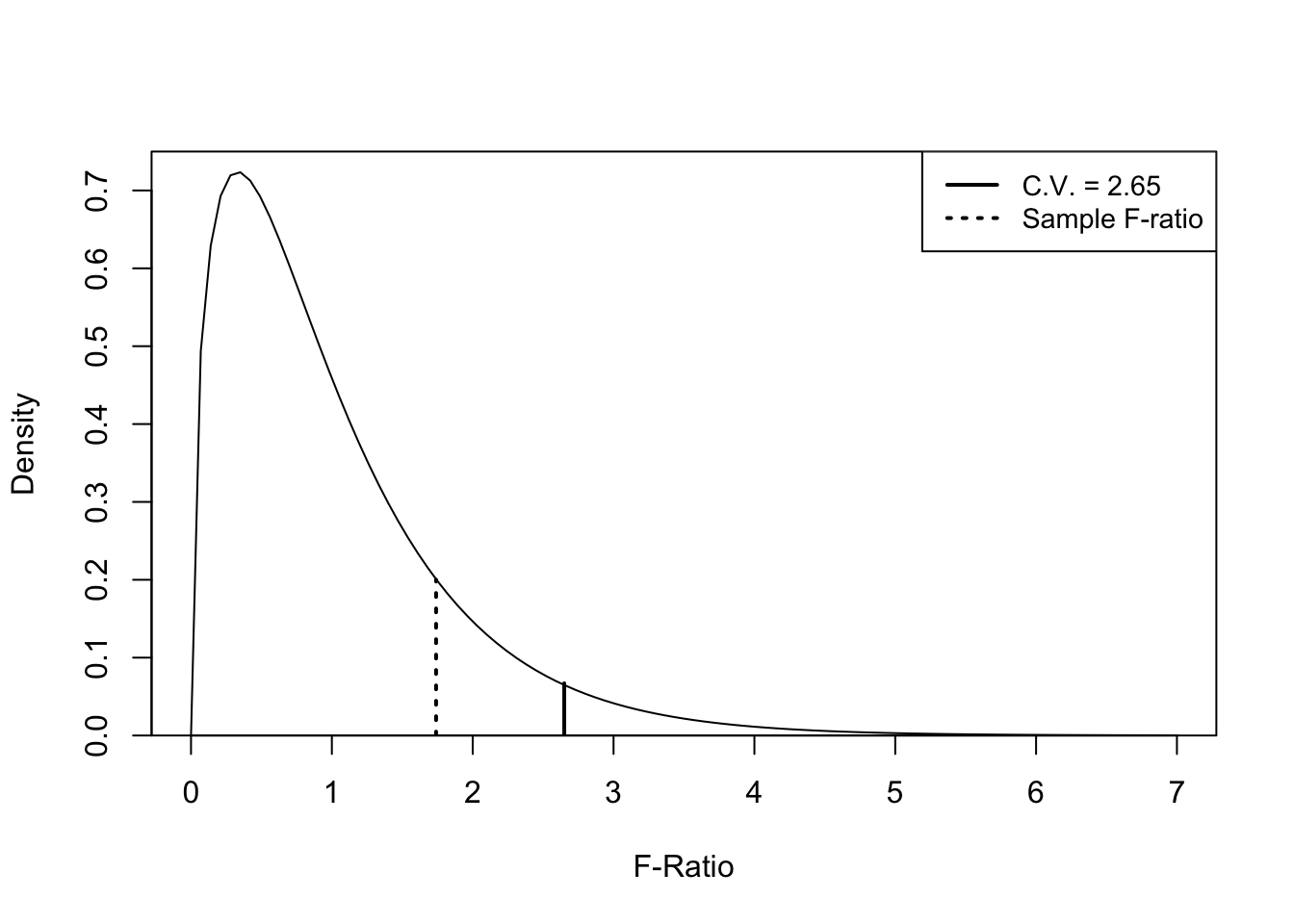
Figure 12.1: Example of a Mosiac Plot
In the mosaic plot in Figure 12.1, the horizontal width of each column reflects the relative sample size for each category of the independent variable, and the vertical height of box within the columns reflects the magnitude of the column percentages. Usually, the best thing to do is focus on how the height of the differently shaded segments (boxes in each row) changes as you scan from left to right. For instance, the height of the light gray bars (low religious importance) increases as you scan from the lowest to highest levels of education, while the darkest segments (high religious importance) generally grow smaller, albeit less dramatically. These changes correspond to changes in the column percentages and reinforce the finding that high levels of education are related to low levels of religiosity. Does the mosaic plot clarify things for you? If so, make sure to take advantage of its availability. If not, it’s worth checking in with your instructor for help making sense of this useful tool.
12.3 Sampling Error
It appears that there is a relationship between education and the religiosity. However, since these data are from a sample, we do not know if we can infer that there is a relationship in the population. As you know by now, if we took another sample, we would get a different table with somewhat different percentages in the cells. Presumably, a table from a second sample would be similar to the findings from the first sample, but there would be differences. The same would be true of any successive samples we might take. And, of course, if there is no relationship between these two variables in the population, some number of samples drawn from that population would still feature differences in the column percentages, perhaps of the magnitude found in our sample, just due to sampling error. What we need to figure out is if the relationship in the table produced by this sample is significantly different from what should be expected if there is no relationship between these two variables in the population.
Think about what this table would look like if there were no relationship between these two variables. In that case, we would expect to see fairly constant percentages as we look from across the columns. We don’t necessarily expect to see exactly the same percentages across the columns; after all, we should see some differences due to sampling error alone. However, the differences in column percentages would be rather small if there were no relationship between the two variables.
But what should we expect those column percentages to be? Since, for the overall sample, we find that about 34% of the cases are in the low importance row (2760 total in that row divided by 8129 total sample size in the table), we should see about 34%, or very slight deviations from that in this row across the columns, if there is no relationship. And the same for the other column percentages within rows; they should be close to the row total percentages (19% for “Moderate”, 47% for “High”).
When evaluating a mosaic plot, if there is no relationship between the independent and dependent variables, the height of the shaded boxes within each row should not vary across columns. In the plot shown above, the height of the boxes does vary across columns, but more so in the first row than in the other two.
12.4 Hypothesis Testing with Crosstabs
The crosstab shown above appears to deviate somewhat from what we would expect to see if there were no relationship between these two variables, but not dramatically. What we need is a test of statistical significance that tells us if the differences that we observe across the columns are large enough that we can conclude that they did not occur due to sampling error; something like a t-test or an F-ratio. Fortunately, we have just that type of statistic available to us.
Chi-square (\(\chi^2\)) is a statistic that can be used to judge the statistical significance of a bivariate table; it compares the observed frequencies in the cells to the frequencies that would be expected if there were no relationship between the two variables. If the differences between the observed and expected outcomes are large, \(\chi^2\) should be relatively large; when the differences are rather small, \(\chi^2\) should be relatively small.
The principle underlying \(\chi^2\) as a test of statistical significance is the same as that which underlies the F-ratio and t-score: we calculate a \(\chi^2\) statistic and compare it to a critical value (CV) for \(\chi^2\). If \(\chi^2\) is greater than the critical value, then we can reject the null hypothesis; if \(\chi^2\) is less than the critical value, we fail to reject the null hypothesis and conclude that there is no relationship between the two variables (in the parlance of chi-square, we would say the two variables are “statistically independent”).
The null and alternative hypotheses for a \(\chi^2\) test are:
H0: No relationship. The two variables are statistically independent.
H1: There is a relationship. The two variables are not statistically independent
Note that H1 specifies a non-directional hypothesis, this is always the case with \(\chi^2\).
To test H0, we calculate the \(\chi^2\) statistic:
\[\chi^2=\sum{\frac{(O-E)^2}{E}}\]
Where:
O=observed frequency for each cell
E=expected frequency for each cell; that is, the frequency we expect if there is no relationship (H0 is true).
Chi-square is a table-level statistic that is based on summing information from each cell of the table. In essence, \(\chi^2\) reflects the extent to which the outcomes in each cell (the observed frequency) deviate from what we would expect to see in the cell if the null hypothesis were true (expected frequency). If the null hypothesis is true, we would expect to see very small differences between the observed and expected frequencies.
We need to use raw frequencies instead of column percentages to calculate \(\chi^2\) because the percentages treat each column and each cell with equal weight, even though there are important differences in the relative contribution of the columns and cells to the overall sample size. For instance, the total number of cases in the “LT HS” column (376) accounts for only 4.6% of total respondents in the table, so giving its column percentages the same weight as those for the “Some Coll” column, which has 34% of all cases, would over-represent the importance of the first column to the pattern in the table.
Let’s walk through the calculation of the chi-square contribution of upper-left cell in the table (Low, LT HS) to illustrate how the cell-level contributions are determined. The observed frequency (the frequency produced by the sample) in this cell is 96. From the discussion above, we know that for the sample overall, about 34% (actually 33.95) of respondents are in the first row of the dependent variable, so we expect to find about 34% of all respondents with less than a high school education in this column. Since we need to use raw frequencies instead of percentages, we need to calculate what 33.95% of the total number of observations in the column is to get the expected frequency. There are 376 respondents in this column, so the expected frequency for this cell is \(.3395*376=127.66\).
#Crosstab with raw frequencies
crosstab(anes20$relig_imp, anes20$educ, plot=F) Cell Contents
|-------------------------|
| Count |
|-------------------------|
===========================================================================
anes20$educ
anes20$relig_imp LT HS HS Some Coll 4yr degr Grad degr Total
---------------------------------------------------------------------------
Low 96 365 860 789 650 2760
---------------------------------------------------------------------------
Moderate 93 284 535 389 275 1576
---------------------------------------------------------------------------
High 187 684 1387 875 660 3793
---------------------------------------------------------------------------
Total 376 1333 2782 2053 1585 8129
===========================================================================A shortcut for calculating expected frequency for any cell is : \[E_{c,r}=\frac{f_c*f_r}{n}\] where fc is the column total for a given cell, fr if the row total, and n is the total sample size. For the upper-left cell in the crosstab: \((376*2760)/8129=127.66\). So the observed frequency for upper-left cell of the table is 96, and the expected frequency is 127.66.
To estimate this cell’s contribution to the \(\chi^2\) statistic for the entire table:
\[\chi^2_c=\frac{(96-127.66)^2}{127.66}=\frac{-31.66^2}{127.66}=\frac{1002.36}{127.66}=7.85\]
To get the value of \(\chi^2\) for the whole table we need to calculate the expected frequency for each cell, estimate the cell contribution to the overall value of chi-square, and sum up all of the cell-specific values.
The table below shows the observed and expected frequencies, as well as the cell contribution to overall \(\chi^2\) for each cell of the table:
#Get expected frequencies and cell chi-square contributions
crosstab(anes20$relig_imp, anes20$educ,
expected=T, #Add expected frequency to each cell
prop.chisq = T, #Total contribution of each cell
plot=F) Cell Contents
|-------------------------|
| Count |
| Expected Values |
| Chi-square contribution |
|-------------------------|
=============================================================================
anes20$educ
anes20$relig_imp LT HS HS Some Coll 4yr degr Grad degr Total
-----------------------------------------------------------------------------
Low 96 365 860 789 650 2760
127.7 452.6 944.6 697.0 538.1
7.852 16.950 7.570 12.131 23.248
-----------------------------------------------------------------------------
Moderate 93 284 535 389 275 1576
72.9 258.4 539.4 398.0 307.3
5.544 2.529 0.035 0.205 3.393
-----------------------------------------------------------------------------
High 187 684 1387 875 660 3793
175.4 622.0 1298.1 957.9 739.6
0.761 6.184 6.091 7.180 8.559
-----------------------------------------------------------------------------
Total 376 1333 2782 2053 1585 8129
=============================================================================First, note that the overall contribution of the upper-left cell to the table \(\chi^2\) is 7.852, essentially the same as the calculations made above. As you can see, there are generally substantial differences between expected and observed frequencies, again indicating that there is not a lot of support for the null hypothesis. If we were to work through all of the calculations and sum up all of the individual cell contributions to \(\chi^2\), we would come up with \(\chi^2=108.2\).
So, what does this mean? Is this a relatively large value for \(\chi^2\)? This is not a t-score or F-ratio, so we should not judge the number based on those standards. But still, this seems like a pretty big number. Does this mean the relationship in the table is statistically significant?
One important thing to understand is that the value of \(\chi^2\) for any given table is a function of three things: the strength of the relationship, the sample size, and the size of the table. Of course, the strength of the relationship and the sample size both affect the level of significance for other statistical tests, such as the t-score and f-ratio. But it might not be immediately clear why the size of the table matters? Suppose we had two tables, a 2x2 table and a 4x4 table, and that the relationships in the two tables were of the same magnitude and the sample sizes also were the same. Odds are that the chi-square for the 4x4 table would be larger than the one for the 2x2 table, simply due to the fact that it has more cells (16 vs. 4). For these two tables, the chi-square statistic is calculated by summing all the individual cell contributions, four for the 2x2 table and sixteen for the 4x4 table. The more cells, the more individual cell contributions to the table chi-square value. Given equally strong relationships, and equal sample sizes, a larger table will tend to generate a larger chi-square. This means that we need to account for the size of the table before concluding whether the value of \(\chi^2\) is statistically significant. Similar to the t-score and F-ratio, we do this by calculating the degrees of freedom:
\[df_{\chi^2} = (r-1)(c-1)\].
Where r = number of rows and c = number of columns in the table. This is a way of taking into account the size of the table.
The df for the table above is (3-1 )( 5-1 )=8
We can look up the critical value for \(\chi^2\) with 8 degrees of freedom, using the chi-square table below.37 The values across the top of the \(\chi^2\) distribution table are the desired levels of significance (area under the curve to the right of the specified critical value), usually .05, and the values down the first column are the degrees of freedom. To find the c.v. of \(\chi^2\) for this table, we need to look for the intersection of the column headed by .05 (the desired level of significance) and the row headed by 8 (the degrees of freedom). That value is 15.51.
Table 12.1: Chi-square Critical Values
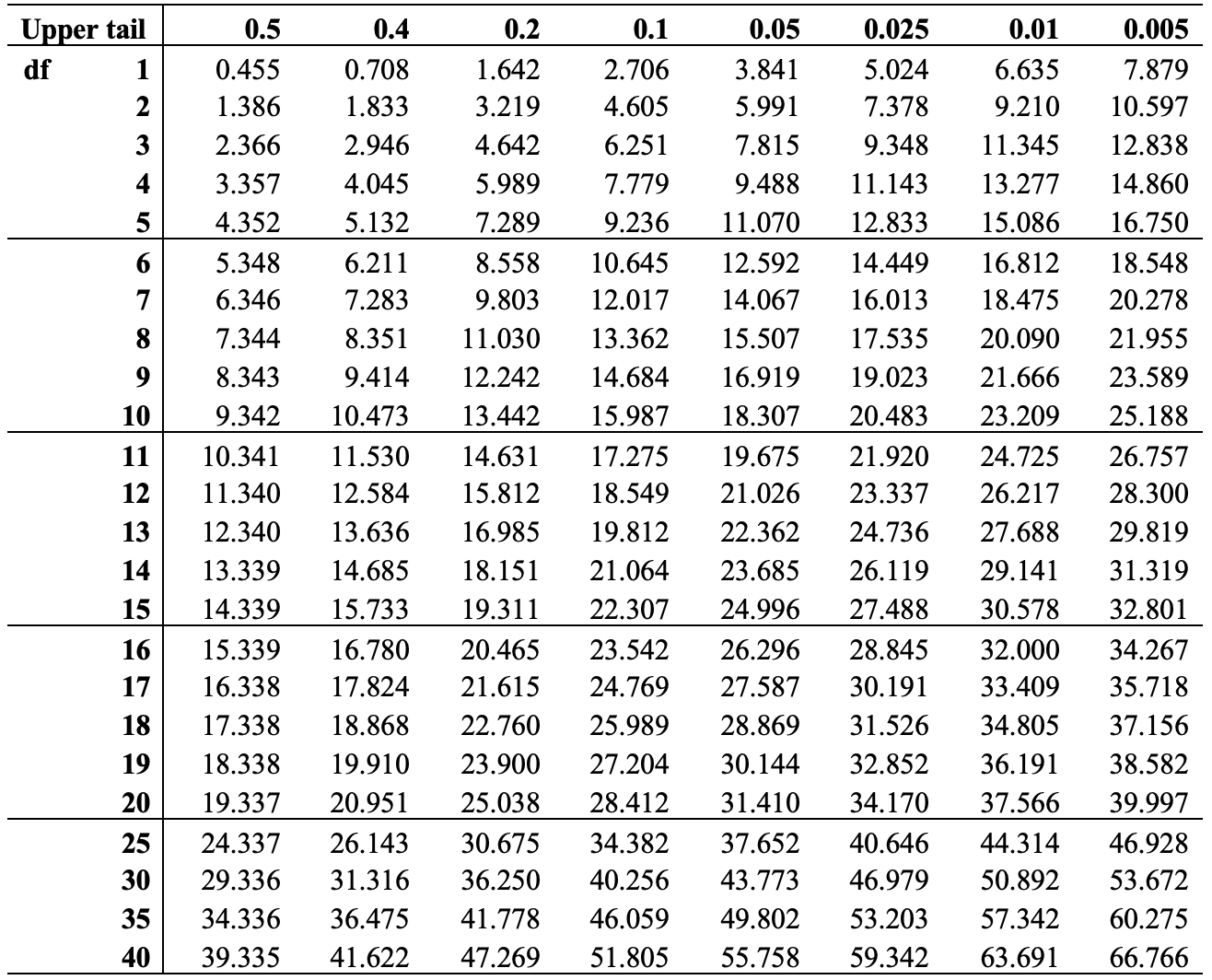
We can also get the critical value for \(\chi^2\) from the qchisq function in R, which requires you to specify the preferred p-value (.05), the degrees of freedom (8) and the upper end of the distribution (lower.tail=F):
#Critical value of chi-square, p=.05, df=8
qchisq(.05, 8, lower.tail=F)[1] 15.51This function confirms that the critical value for \(\chi^2\) is 15.51. Figure 12.2 illustrates location of chi-square value of 15.51 in a chi-square distribution when df=8. The area under the curve to the right of the critical value equals .05 of the total area under the curve, so for any obtained value of chi-square greater than 15.51, the p-value is less than .05 and the null hypothesis can be rejected. In the example used above, \(\chi^2=108.2\), a value far to the right of the critical value, so we reject the null hypothesis. Based on the evidence presented here, there is a relationship between level of education and the importance of religion in one’s life.
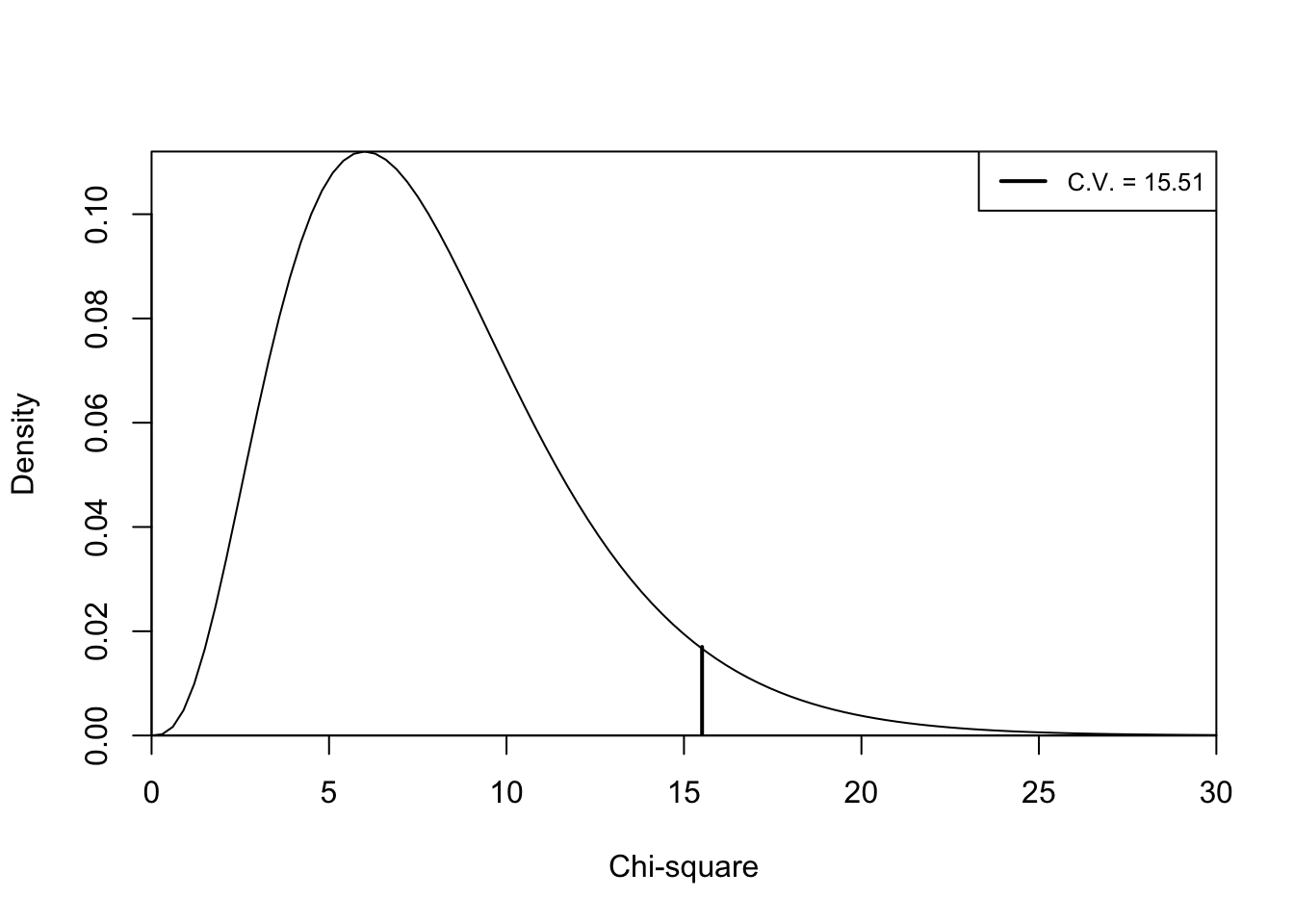
Figure 12.2: Chi-Square Distribution, df=8
You can get the value of \(\chi^2\), along with degrees of freedom and the p-value from R by adding chisq=T to the crosstab command. You can also get it from R by using the chisq.test function, as shown below.
#Get chi-square statistic from R
chisq.test(anes20$relig_imp, anes20$educ)
Pearson's Chi-squared test
data: anes20$relig_imp and anes20$educ
X-squared = 108, df = 8, p-value <2e-16Here, we get confirmation of the value of \(\chi^2\) (108), and degrees of freedom (8). We also get a more precise report of the p-value (area on the tail of the distribution, beyond our chi-square value). In this case, we get scientific notation (p<2e-16), which tells us that p< .0000000000000002, a number far less than the cutoff point of .05. In cases like this, you can just report the p< .05.
12.4.1 Regional Differences in Religiosity?
Let’s take a look at another example, using the same dependent variable, but switching to a different independent variable. In the table below, we examine the regional differences in the importance of religion. Traditionally, the American South and parts of the Midwest are thought of as the “Bible Belt,” so we expect to see distinctive outcomes across the four broadly defined regions in the ANES data (anes20$V203003): Northeast, Midwest, South and West. Of course the null and alternative hypotheses are:
H0: No relationship. Importance of religion and geographic region are statistically independent
H1: There is a relationship. Importance of religion and region are not statistically independent.
Let’s take a look at the crosstab and mosaic plot for this pair of variables. In both the column percentages and in the mosaic plot, there appear to be pronounced differences in religiosity across region. Southerners and midwesterners standout as placing the greatest importance on religion while northeastern and western state residents place the least importance on Religion. Southerners stand out on one end of the scale, with 56% in the highly important category and just 26% in the low importance category, while western state residents are at the other end of the scale with 38% in the high category compared to 39% in the low category.
crosstab(anes20$relig_imp, anes20$V203003,
prop.c=T,
chisq=T, #Add chi-square value to the crosstab
plot=T) Cell Contents
|-------------------------|
| Count |
| Column Percent |
|-------------------------|
==========================================================================
SAMPLE: Census region
anes20$relig_imp 1. Northeast 2. Midwest 3. South 4. West Total
--------------------------------------------------------------------------
Low 549 649 811 782 2791
39.4% 32.6% 26.4% 43.5%
--------------------------------------------------------------------------
Moderate 320 385 548 343 1596
23.0% 19.3% 17.9% 19.1%
--------------------------------------------------------------------------
High 525 956 1710 671 3862
37.7% 48.0% 55.7% 37.4%
--------------------------------------------------------------------------
Total 1394 1990 3069 1796 8249
16.9% 24.1% 37.2% 21.8%
==========================================================================
Statistics for All Table Factors
Pearson's Chi-squared test
------------------------------------------------------------
Chi^2 = 238.2 d.f. = 6 p <2e-16
Minimum expected frequency: 269.7 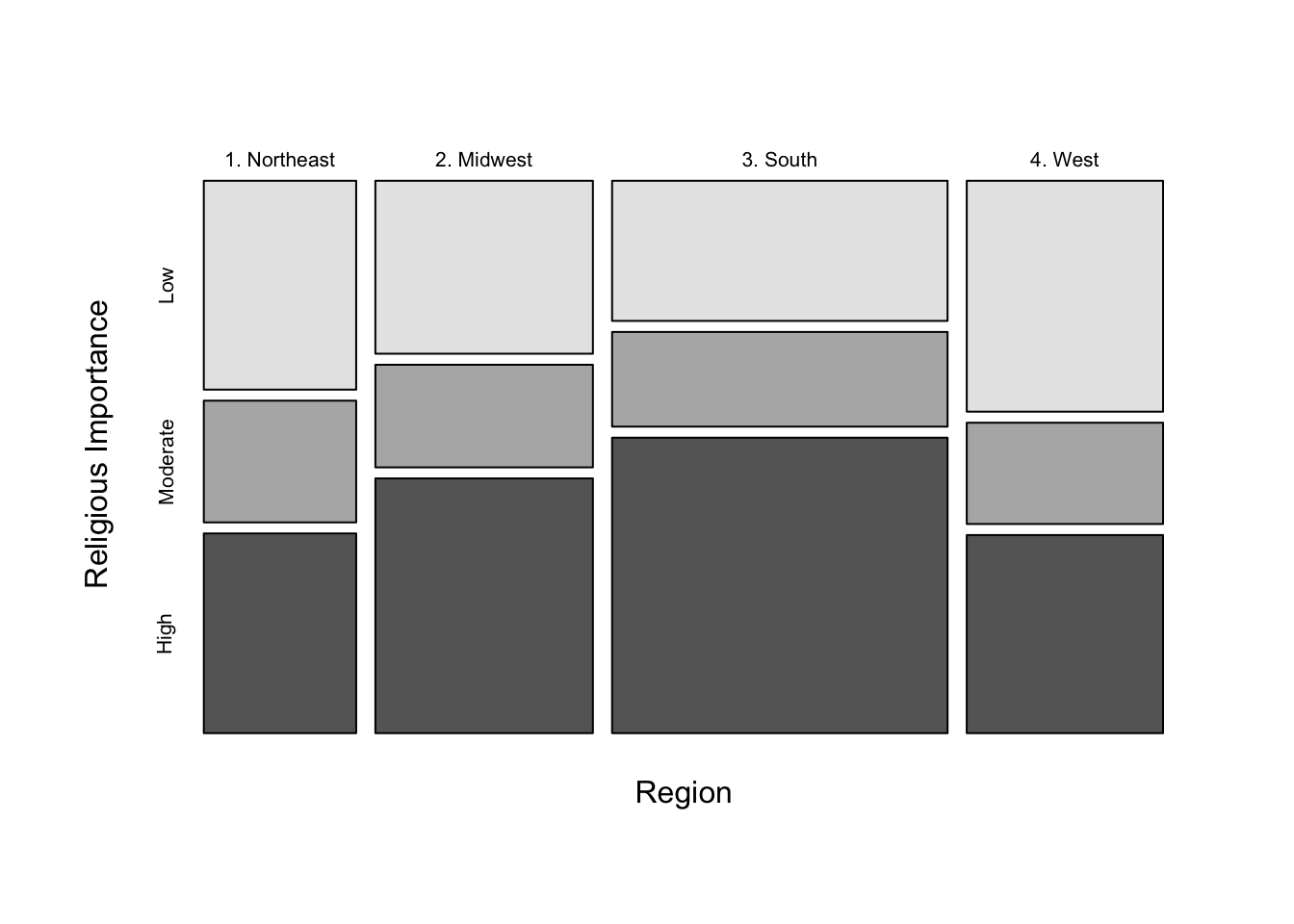
The chi-square statistic (238.2) and p-value (less than .05) confirm that there is a relationship between these two variables, so we can reject the null hypothesis. There is a relationship between region of residence and the importance one assigns to religion.
12.5 Directional Patterns in Crosstabs
We have two different types of independent variables in the two examples used above. In the first crosstab, the independent variable is ordered, ranging from low to high levels of education, whereas in the second example the independent variable is a nominal variable with each category representing a different region of the country. In both cases, the dependent variable is ordered from low to high levels of importance attached to religion. The difference in level of measurement for the independent variables has implications for the types of statements we can make about the patterns in the tables. In both cases, we can discuss the fact that the column percentages vary from one column to the next, indicating that outcomes on the independent variable affect outcomes on the dependent variable. We can go farther and also address the direction of the relationship between the education and religious importance because the measure of educational attainment has ordered categories. Generally, with ordered data we are interested not just in whether the column percentages change, but also in whether the relationship is positive or negative. Are high values on the independent variable generally associated with low or high values on the dependent variable? This question makes sense when the categories of the independent and dependent variables can be ordered.
The extent to which there is a positive or negative relationship depends on the pattern of the percentages in the table. In crosstabs, generally, the cell in the upper-left corner of the table is technically the lowest-ranked category for both variables, regardless of how the categories are labeled. This is why it is usually a good idea to recode and relabel ordered variables so the substantive meaning of the first category can be thought of as “low” or “negative” in value on whatever the scale is. When assessing directionality we want to know how moving across the columns from low to high outcomes of the independent variable changes the likelihood of being in low or high values of the dependent variable. If low values of the independent variable are generally associated with low values of the dependent variable, and high values with high values, then we are talking about a positive relationship. When low values of one variable are associated with high values of another, then the relationship is negative. Check out the table below, which provides generic illustrations of what positive and negative relationships might look like in a crosstab.

Figure 12.3: Demonstration of Positive and Negative Patterns in Crosstabs
For positive relationships, the column percentages in the “Low” row drop as you move from the Low to High columns, and increase in the “High” row as you move from the Low to High column. So, Low outcomes tend to be associated with Low values of the independent variable, and High outcomes with High values of the independent variable. The opposite pattern occurs if there is a negative relationship: Low outcomes tend to be associated with High values of the independent variable, and High outcomes with Low values of the independent variable.
Let’s reflect back on the crosstab between education and religious importance. Does the pattern in the table suggest a positive or negative relationship? Or is it hard to tell? Though it is not as clear as in the hypothetical the pattern in Figure 12.3, there a negative pattern in the first crosstab: the likelihood of being in the “low religious importance” row increases across columns as you move from the lowest to highest levels of education, and there is a somewhat weaker tendency for the likelihood of being in the “high religious importance” row to decrease across columns as you move from the lowest to highest levels of education. High values on one variable tend to be associated with low values on the other, the hallmark of a negative relationship.
12.5.1 Age and Religious Importance
Let’s take a look at another example, one where directionality is more apparent. The crosstab below still uses importance of religion as the dependent variable but switches to a five-category variable for age as the independent variable. Both the table percentages and the mosaic plot show a much stronger pattern in the data than in either of the previous examples. The percent of respondents who assign a low level of importance to religions drops precipitously from 50.4% among the youngest respondents to just 19.4% among the oldest respondents. At the same time, the percent assigning a high level of importance to religions grows steadily across columns, from 30.7% in the youngest group to 63.1% in the oldest group. As you might expect, given the strength of this pattern, the chi-square statistic is quite large and the p-value is very close to zero. We can reject the null hypothesis. There is a relationship between these two variables.
#Collapse age into fewer categories
anes20$age5<-cut2(anes20$V201507x, c(30, 45, 61, 76, 100))
#Assign labels to levels
levels(anes20$age5)<-c("18-29", "30-44", "45-60","61-75"," 76+")
#Crosstab with mosaic plot and chi-square
crosstab(anes20$relig_imp, anes20$age5, prop.c=T,
plot=T,chisq=T,
xlab="Age",
ylab="Religious Importance") Cell Contents
|-------------------------|
| Count |
| Column Percent |
|-------------------------|
=================================================================
PRE: SUMMARY: Respondent age
anes20$relig_imp 18-29 30-44 45-60 61-75 76+ Total
-----------------------------------------------------------------
Low 505 877 666 522 135 2705
50.4% 43.7% 32.3% 24.4% 19.4%
-----------------------------------------------------------------
Moderate 189 357 396 470 122 1534
18.9% 17.8% 19.2% 22.0% 17.5%
-----------------------------------------------------------------
High 308 774 1003 1149 440 3674
30.7% 38.5% 48.6% 53.7% 63.1%
-----------------------------------------------------------------
Total 1002 2008 2065 2141 697 7913
12.7% 25.4% 26.1% 27.1% 8.8%
=================================================================
Statistics for All Table Factors
Pearson's Chi-squared test
------------------------------------------------------------
Chi^2 = 396.7 d.f. = 8 p <2e-16
Minimum expected frequency: 135.1 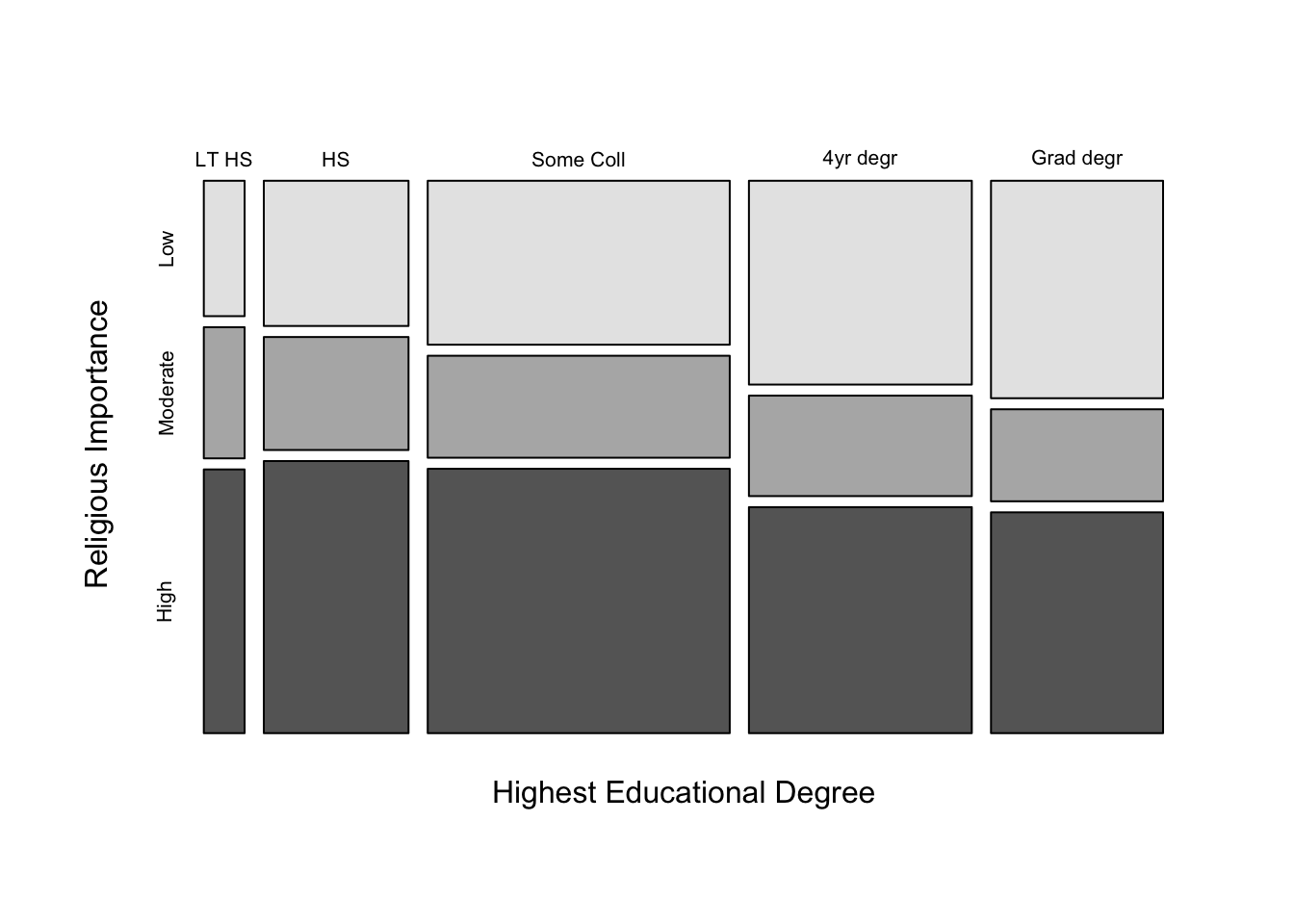
The pattern is also clear in the mosaic plot, in which the height of the light gray boxes (representing low importance) shrinks steadily as age increases, while the height of the dark boxes (representing high importance) grows steadily as age increases.
We should recognize that both variables are measured on ordinal scales, so it is perfectly acceptable to evaluate the table contents for directionality. So what do you think? Is this a positive or negative relationship? Whether focusing on the percentages in the table or the size of the boxes in the mosaic plot, the pattern of the relationship stands out pretty clearly: the importance respondents assign to religion increases steadily as age increases. There is a positive relationship between age and importance of religion.
12.6 Limitations of Chi-Square
Like the t-score, z-score, and F-ratio, chi-square is a test statistic that can be used as a measure of statistical significance. Based on the value of chi-square, we can determine if an observed relationship between two variables is different enough from what would be expected under the null hypothesis that we can reject H0.
Like other tests of statistical significance, chi-square does not tell how strong the relationship is. As you can see from the three crosstabs above, all three relationships are statistically significant but there is a lot of variation in the strength of the relationships. Of course, the other tests for statistical significance also don’t directly address the strength of the relationship between two variables. That is not their purpose, so it is not really a “problem” with measures of significance. The problem, though, is the tendency to treat statistically significant relationships as important without paying close attention to effect size. It does not hurt to emphasize an important point: statistical significance \(\ne\) substantive importance or impact.
One other limitation of chi-square is that it does not provide information about the direction of the relationship, just that the pattern is different than expected under the null hypothesis. Even though a directional hypothesis for the relationship between age and religious importance makes sense, chi-square does not test for directionality, it just tests to see if the observed outcomes are sufficiently different from the expected outcomes that we can reject the null hypothesis. You can tell if there is a directional relationship by looking at the pattern in the table, but chi-square does not address the significance of the directional relationship.
12.7 Next Steps
As you might have guessed from the last few paragraphs, we will move on from here to explore ways in which we can use measures of association to assess the strength and direction of relationships in crosstabs. Following this, the rest of the book focuses on estimating the strength and statistical significance of relationships between numeric variables. In some ways, everything in the first 13 chapters of this book establishes the foundation for exploring relationships between numeric variables. I think you will find these next few chapters particularly interesting and surprisingly easy to follow. Of course, that’s because you’ve laid a strong base with the work you’ve done throughout the rest of the book.
12.8 Exercises
12.8.1 Concepts and Calculations
-
The table below shows the relationship between age (18 to 49, 50 plus) and support for building a wall on the U.S. border with Mexico.
State the null and alternative hypotheses for this table.
There are three cells missing the column percentages (Oppose/18-49, Neither/50+, and Favor/18-49). Calculate the missing column percentages.
After filling in the missing percentages, describe the relationship in the table. Does the relationship appear to be different from what you would expect if the null hypothesis were true? Explain yourself with specific references to the data.
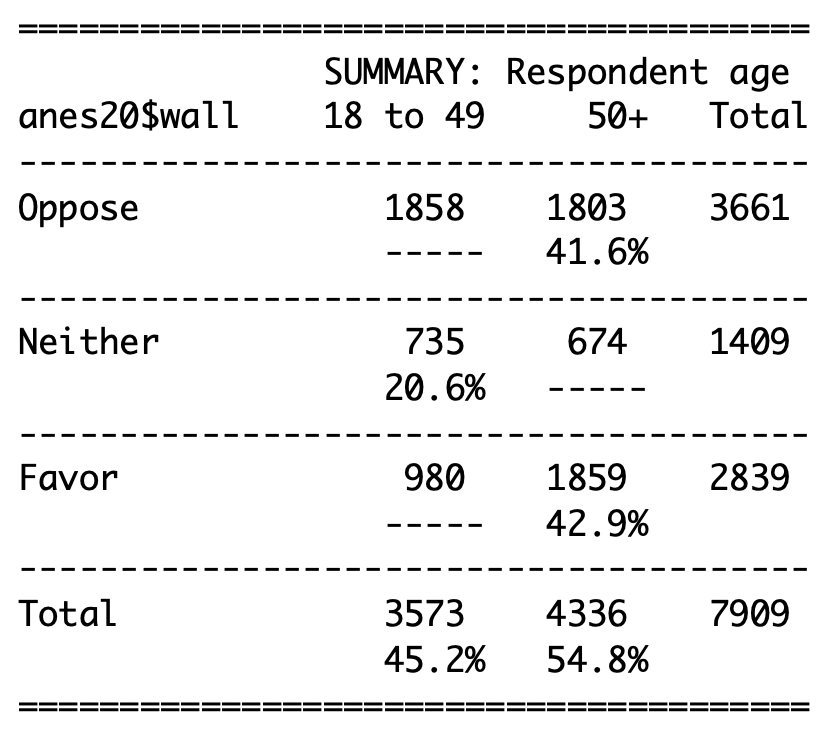
-
The same two variables from problem 1 are shown again in the table below. In this case, the cells show the observed (top) and expected (bottom) frequencies, with the exception of three cells.
Estimate the expected frequencies for the three cells in which they are missing.
By definition, what are expected frequencies? Not the formula, the substantive meaning of “expected.”
Estimate the degrees of freedom and critical value of \(\chi^2\) for this table
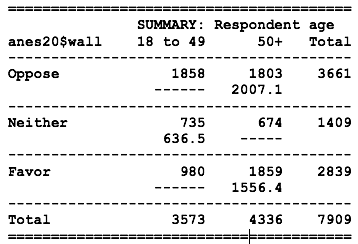
- The mosaic plot below illustrates the relationship between respondent race/ethnicity and support for building a wall at the U.S. border with Mexico. What does the mosaic plot tell you about both the distribution of the independent variable and the relationship between racial and ethnic identity and attitudes toward the border wall? Is this a directional or non-directional relationship?
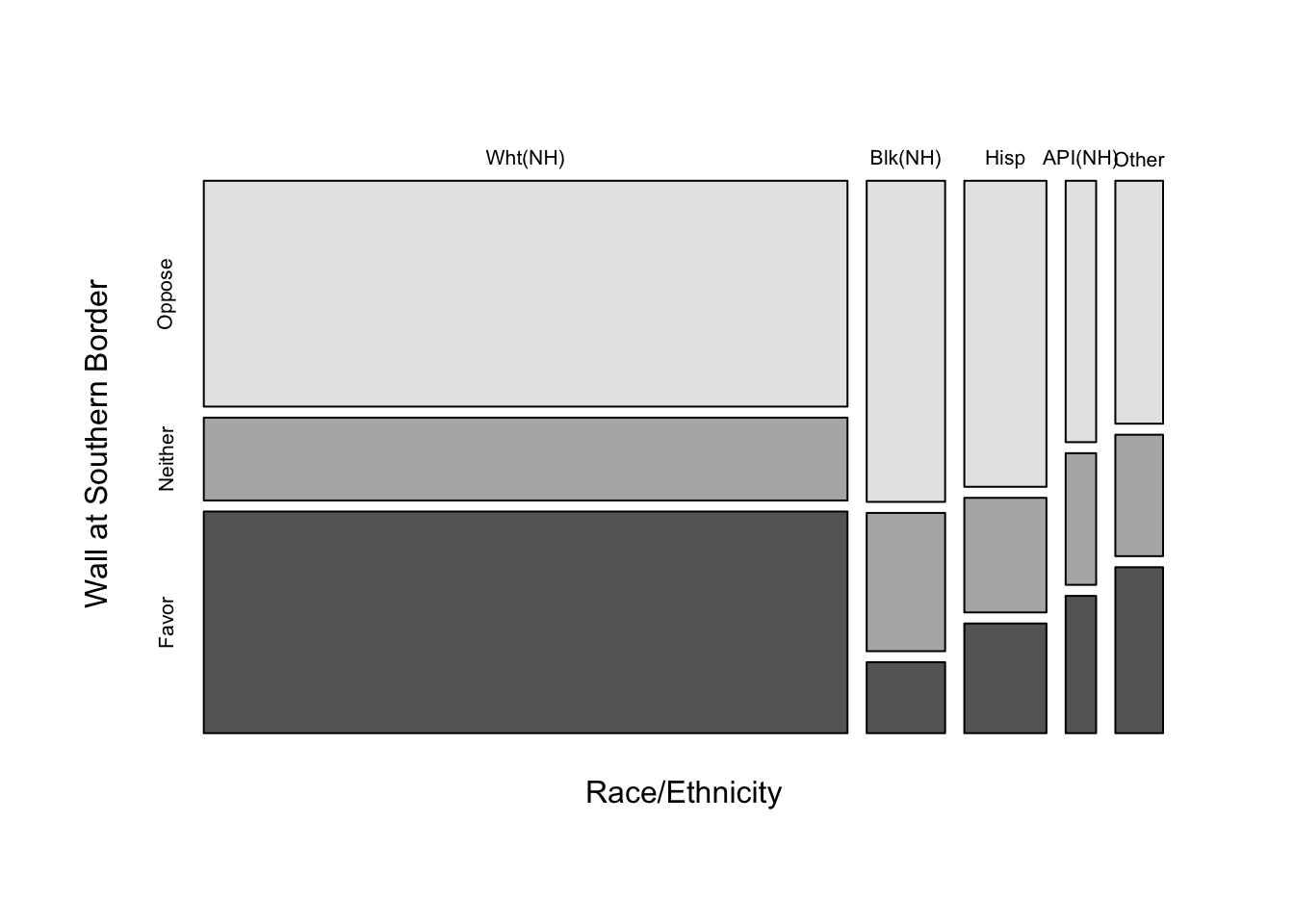
- The table below illustrates the relationship between between family income and support for a wall at the southern U.S. border. Describe the relationship, paying special attention to statistical significance, strength of relationship, and direction of relationship. Make sure to use column percentages to bolster your case.
Cell Contents
|-------------------------|
| Count |
| Column Percent |
|-------------------------|
======================================================================
PRE: SUMMARY: Total (family) income
anes20$wall Lt 50K 50K-75K 75k-125K 125K-175K 175K+ Total
----------------------------------------------------------------------
Oppose 1176 674 867 370 482 3569
43.9% 43.6% 47.9% 49.4% 55.7%
----------------------------------------------------------------------
Neither 561 278 262 112 129 1342
20.9% 18.0% 14.5% 15.0% 14.9%
----------------------------------------------------------------------
Favor 941 594 681 267 254 2737
35.1% 38.4% 37.6% 35.6% 29.4%
----------------------------------------------------------------------
Total 2678 1546 1810 749 865 7648
35.0% 20.2% 23.7% 9.8% 11.3%
======================================================================
Statistics for All Table Factors
Pearson's Chi-squared test
------------------------------------------------------------
Chi^2 = 73.31 d.f. = 8 p = 0.00000000000107
Minimum expected frequency: 131.4